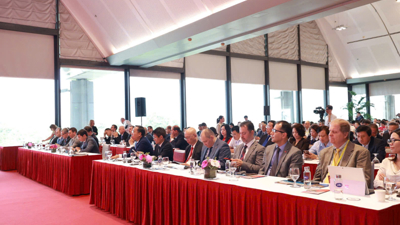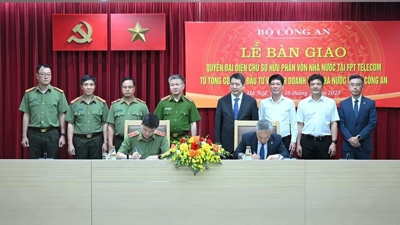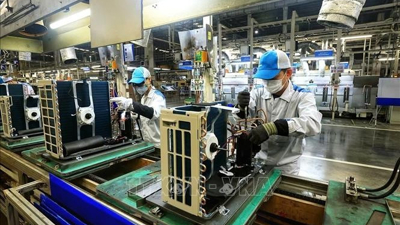Phuc Khang Corporation fully behind green development
Ms. Luu Thi Thanh Mau, CEO of the Phuc Khang Corporation, has made a strong commitment to developing green finance and credit and enhancing legal documents on green building standards.

State President Nguyen Xuan Phuc met and congratulated the Vietnam Young Entrepreneurs Association delegation at the Presidential Palace for the Red Star Awards ceremony for young entrepreneurs. The meeting saw many practical proposals, initiatives, and recommendations made to develop a strong team of businesses and entrepreneurs as a driving force for Vietnam’s economic development.
Ms. Luu Thi Thanh Mau, CEO of the Phuc Khang Corporation and Permanent Vice President of the Vietnam Young Entrepreneurs Association, said at the meeting that it is necessary to strengthen the development of green finance and credit and enhance legal documents on green building standards.
She and other enterprise representatives also raised their opinions with the President, emphasizing green finance and green building proposals. Ms. Mau sincerely thanked the government and ministries for their timely policies, for applying unprecedented and drastic measures to prevent and control the pandemic, and for creating momentum for economic and social recovery and development.
She also expressed her appreciation of decisions to support credit with priorities for rural areas, exports, small and medium-sized enterprises (SMEs), supporting industry, and applying high technology, with a maximum interest rate of only 4.5 per cent per annum for economic development.
The business leader proposed the government expand policies for businesses with strategic plans for sustainable development, particularly in green building.
“We can focus on this group of businesses for setting up green financial policies with specific conditions and requirements,” Ms. Mau said. “Developing a green financial system to promote a green economy in Vietnam is a vital factor for sustainable development. Currently, the tool to mobilize green finance is mainly used to issue green bonds, while green credit has not developed fast or strongly enough.”

According to the Ministry of Finance (MoF), as of June 30, 2022, outstanding credit for green projects reached more than VND474 trillion ($20.6 billion), accounting for only 4.1 per cent of total outstanding loans in the whole economy.
Ms. Mau proposed that the government promote green finance and green credit and encourage and increase both the quantity and quality of enterprises participating in sustainable development.
Known for pioneering the creation of a better lifestyle for public health and a sustainable human and ecological environment, Ms. Mau has spent many years researching green building development.
She believes that one of the most effective ways to contribute to the recovery and create momentum in Vietnam’s economic development is through creating green buildings and energy-effective urban areas, ensuring adaptation to large-scale climate change, the sustainable management of natural resources and biodiversity, and green economic development.
“Green growth is becoming an inevitable trend that many businesses have chosen for developing their business,” she said. “Developing green buildings and urban areas is a meaningful and feasible strategy.”
According to the Ministry of Construction (MoC), by 2030, green economic development can reduce emissions by up to 25 per cent, limiting global temperature rises to below the threshold of 2 degrees, per the Paris Agreement on climate change.
Ms. Mau also said that the lack of a legal framework presented difficulties to enterprises pursuing green buildings in Vietnam. “There is no legal document that fully stipulates the criteria that are the basis for assessing green buildings,” she explained. “In fact, the evaluation of a certain project that meets the criteria of a green building is still spontaneous from investors.”
Over the past ten years, more than 200 green buildings have been recognized in Vietnam, with a total floor area of more than 6 million sq m, according to the MoC. This figure is actually quite small compared to the more than 100 million sq m of floor space built annually in Vietnam.
Other countries in the region have issued legal frameworks specifically for green buildings, such as the 2015 Green Building Code in the Philippines. This framework creates more favorable conditions for State management and green building development.
At many seminars, forums, and meetings, Ms. Mau has expressed her enthusiasm and consistently progressive mindset on green building. “Green building is a vehicle for the Phuc Khang Corporation to make good on the right products in line with the world’s trends, spreading a spirit of green living to everyone and contributing to the country’s strategy on sustainable development,” she said.
“Creating a green urban area is to create a high-quality, humane, and ecological living environment for residents and at the same time contribute to solving global problems. From green buildings, we will get green and sustainable cities. If green buildings are supported by green financial policies, they will contribute greatly to reducing greenhouse gas emissions by 2030 and help the country reach its target of net-zero emissions by 2050.”







